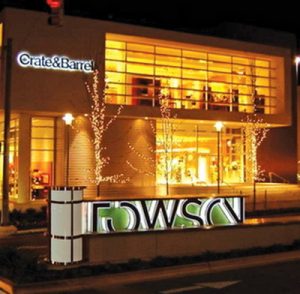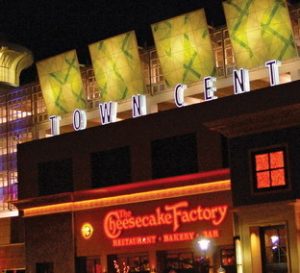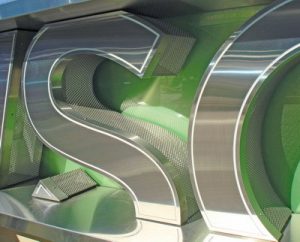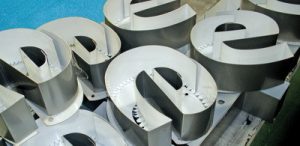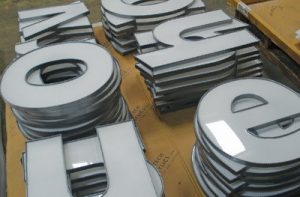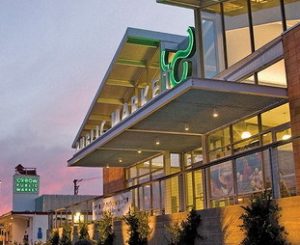Dimensional Signs
Channeling Your Energies
Channel-letter fabricators and equipment vendors weigh in on market trends.
Published
15 years agoon
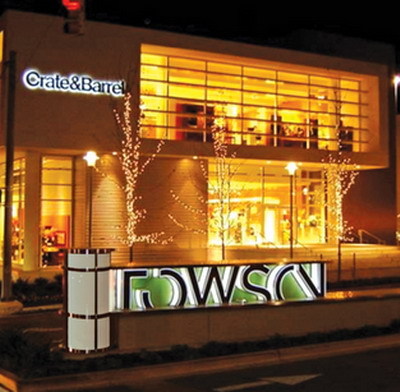
Channel letters have long enjoyed being among the most reliable types of electric signs available. According to the 2008 Electric State of the Industry report (see ST, July 2009, Table 7, page 71), nearly 96% of responding shop owners manufacture channel letters, and the sign type represents 25.3% of these shops’ revenue – neck-and-neck with cabinet signs for respondents’ leading revenue stream.
Of course, channel letters serve as an apt barometer for electric-sign manufacturers’ migration from neon to LEDs as their lightsource of choice. According to the 2008 Lighting Survey (see ST, March 2009, page 76), respondents cited usage of LEDs for 60.6% of their signage applications. Among those surveyed, two-thirds increased their LED usage versus the prior year. In turn, the groundswell of demand for LEDs for channel-letter applications has triggered the number of LED manufacturers to mushroom. This hyperactive market has spurred the companies to attempt to match or surpass their competition by delivering better products at increasingly competitive prices. Fabrication-equipment and plastics manufacturers have also taken steps to improve their offerings to yield better productivity. No company has been immune from a long-lingering recession, but numerous industry sources point to a prosperous future for channel letters.
$image1
$image2
$image5
Wholesale manufacturers
Advertisement|2288| (Watertown, SD) has produced wholesale channel letters for 20 years. Current owner Mark Stein purchased the company from his father, Clint, in 1989. In addition to channel letters, Esco produces sign cabinets, message centers and formed signfaces, among other sign types. Jenny Wika, the company’s channel-letter supervisor, said the shop now fabricates at least 80% of its channel letters with LEDs. The customers typically make the choice. Esco has decreased the number of frontlit channel letters it produces with neon.
“The end users are becoming much more knowledgeable about available lighting technologies, and they’re aware of the energy savings LEDs can provide,” she said.
According to Wika, LEDs’ ease of use and performance (particularly with respect to white, the most-ordered color) makes them a logical choice for this application.
$image3
“With the wider viewing angle of new-generation LEDs, the color and depth of a sign are less important than they used to be,” she said. “As long as you follow the manufacturer’s instructions for installing the modules, and use an appropriate product for your application, [LEDs] can handle virtually any size, return or stroke.”
To fabricate its channel letters, Esco uses Computerized Cutters’ (Plano, TX) Accu-Bend metal-bending equipment, a Chief Enterprises Letterlok 4000 return fastener and, to produce backlit letters, an Arete ReturnShop.
AdvertisementAs a clear indicator of the market’s shift, Wika said the shop now employs three tubebenders; three years ago, Esco employed five. Exposed and pan-face channel letters comprise the bulk of the shop’s neon projects.
She said, “When a customer specs neon, it’s usually central to a specific image or theme they want to convey. When a customer just wants a cost-effective, channel-letter lightsource, it’s almost automatically LEDs.”
$image4
Wika said Esco’s most challenging channel-letter project to date comprised a 24.5-ft.-diameter, halo-lit, white-LED-illuminated logo. To boost its reflectivity, Esco fabricated an inside channel around the perimeter that forced light out the returns’ sides. Then, they mounted it to a shoebox, aluminum face and separated it in half for shipping.
“We’ve produced large, frontlit logos before, but the halo-lit application proves challenging because we had to ensure enough light emitted out of the cans.”
|1361| (Bonduel, WI), which just celebrated its 50th anniversary (see ST, July 2009, page 66), also operates the Channel Letter Factory, which produces its namesake signs in Bonduel and at a second plant in Carson City, NV. Overall, channel letters represent approximately 40% of the company’s business. Bernie Ostrenga, World Wide’s director of sales and marketing, said certain markets have been hit particularly hard by rough economic waters.
Advertisement“Companies that manage national sign programs have been hit hard by the economic slowdown,” Ostrenga said. “Orders from banks and financial-services companies have been cut or delayed significantly. Retail customers have also scaled back pretty sharply.”
Ostrenga said the company fabricates approximately two-thirds of its channel letters with LEDs. He said, unless a customer incorporates an exposed-letter program, wants an extremely bright sign or has to compete directly with a neon sign, LEDs offer a very desirable lighting option.
Ostrenga lauds the enhanced viewing angle new-generation LEDs offer, which helps fabricators create effective channel letters with less depth.
“Just in the last couple of years, the quality of white LEDs has improved enormously,” he said. “They used to emit sort of a pale, gray light, but, now, the light is much warmer. We use three or four different LED vendors, and the quality has risen exponentially across the board.”
|2511| (SBI), Birmingham, AL, has fabricated channel letters since 1985. According to Randy Wade, SBI’s sales manager, the company has gradually progressed from two channel-letters sets per week to 50. Overall, channel letters represent roughly 30% of the company’s business.
“Like most wholesale signshops, we’ve been affected by the economy,” Wade said. “It seems that when [retail] shops’ installations slow down, they bring more work back in-house. Some of our work for national accounts has dropped, but only by a slight percentage.”
Wade estimates that LEDs illuminate 40% of SBI’s channel letters. He noted that newer LEDs offer better functionality because new module components make them easier to wire in the shop and install in the field. However, Wade still believes white LEDs don’t match neon’s brightness, so SBI still primarily fabricates such jobs with neon.
Its channel-letter fabrication equipment includes two Logixx routers (one 8 x 20 ft. and the other 8 x 12 ft.), which rout the plastic backs and faces, a Logixx pre-forming machine that creates the returns, an Accu-Bend for notching and bending, and two staple machines that join returns and letterbacks. SBI also operates a Mimaki JV-3 250 Baby Grand solvent-ink printer for creating letterface overlays.
Wade said channel-letter manufacturers are still “catching their breath” from keeping up with LEDs’ exponential improvements and increasing viability for the channel-letter market. He continued, “I don’t see any imminent trends, but this industry continues to grow and evolve, and I look forward to the future of the channel-letter business.”
|2680| (Denver) has fabricated channel letters for eight years, according to John Lewis, the company’s president. He said the company’s national-account business sustained a downturn in the last several months, but that custom-sign orders had increased during the same period. Regarding the tough economic state, he commented, “We’ve taken economic challenges as an opportunity to make our operation leaner, review job duties, and make our material choices and processes as cost-effective as possible.”
Lewis said the company’s channel letter lightsource divides roughly equally between neon and LEDs. He also the comparative merits of each technology: “I admit that, at heart, I’m a neon guy. I just love the look of a traditional set of neon channel letters. You can create a lot of effects with neon. With an electronic transformer [to power neon], there’s really not a major difference in energy consumption between the technologies. However, LEDs have improved ten-fold in five years, and offer a great solution for production jobs.”
In July, the company reduced its LED prices by 30%. Direct Sign Wholesale bid out its LED business and, based on the high-volume order, a vendor offered white LEDs for the same price as what neon would cost to power the same quantity of signs.
“By the end of the year, I think 75% of our channel letters will incorporate LEDs,” Lewis said.
Although the wider viewing angle of new LEDs has reduced hotspots, he still specs a diffuser plastic film for his channel-letter faces. Lewis typically chooses Altuglas’ Plexiglas® 2447 acrylic diffuser film because he said it offers the best diffraction properties.
Lewis foresees Darwinism ahead for LED manufacturers: “Companies will need to keep up with customer demand, or they’re finished. There are so many vendors on the market, and they all look fine on their own, but the difference can be tremendous side-by-side. The market’s expectations for LEDs are growing every day.”
|2845| (Crested Butte, CO) entered the channel-letter market approximately three years ago. Trea Scortino, son of the company’s founder, Warren Scortino Jr., said the company fabricates it letters exclusively with LEDs because of their cost effectiveness and energy savings. He said analyzing the LED modules offered to the sign market has become “a hobby.”
“The LED manufacturers use a lot of the same technology – about 80% of them use the same diode,” Scortino said. “The top industry players just seem to do a better job of marketing.”
He said one of the most important LED advances entailed shifting from “superflux” modules – which Scortino equated to those within an LED-lit flashlight – to surface-mount, cluster technology, which made module layout easier. The next evolution involved placing a surface-mounted chip within a tiny rectangle with a wider viewing angle.
“In addition to brightness, it’s important to find modules designed to minimize heat, because heat is death to an LED,” Scortino said.
He praises GE Lumination’s Tetra® as the most durable LED product – and lauds the performance its 165° viewing angle allows — but said, given frequent rebranding and sign turnover, durability may not loom as a key concern. He also specs J’s LED’s 0.7W “super module” for many projects.
“We’ve tested our letters lit with this module against 7,500mm, double-stroke, white neon, and the LED prevailed,” Scortino said.
$image6
Let there be light
|2274| (Ventura, CA) has manufactured LED-based, channel-letter lighting solutions for 10 years. According to Jim Sloan, the company’s president, the company has developed five generations of modules. Traditionally, the LED market seems to mimic Moore’s law (Intel Corp. co-founder Gordon E. Moore first theorized that the number of transistors that could be placed on a circuitboard while yielding an affordable product would double every two years).
The company offers ChanneLED 5, its newest, all-purpose product for face- and halo-lit letters, V Series, a low-profile system for shallow and narrow applications; Great White 3, a white Led tailored to deep, tall and large channel letters; and ChanneLED 4, it’s previous-generation, all-purpose product.
“Through research and development, and keeping up with market demands, successful LED-product manufacturers have advanced brightness and color consistency at a lower cost,” Sloan said. “I think the sign market maintains much more exacting standards than other LED applications, such as cellphones. Sign customers are much more demanding in the brightness and color fidelity in the signage they buy. We source products from four LED manufacturers, and constantly work towards efficient design.”
He said the first step involves simply selecting the right product for the job: “If you choose a high-power module for a thin-stroke letter set, it’s going to overpower the sign and create hot spots.”
When retrofitting an existing sign with LEDs, Sloan said a clean interior surface is vital. Otherwise, the modules often bond poorly to the backs and slide to the bottom. He also said it’s key to follow manufacturer recommendations for power-source usage, and to ensure electrical connections are sealed off with silicone and no wires are exposed.
ElectraLED (Largo, FL) has offered LED products for eight years. Bryan Warner, the company’s sales VP, said the ongoing improvements of white LEDs represent the most significant advancement.
“Early-generation, white LEDs emitted light in the range of 6.500K, which matched general lighting applications, but wasn’t sufficient for many signs,” Warner said. “Now it’s in the range from 6,500-3,000K and exceeds 70 lumens per watt.”
The company’s offerings include Flex™, which the company offers in eight colors for medium- to large-format channel letters; MiniFlex, which matches smaller-format letter sets; Genesis™, an all-purpose system that’s available in six colors. The company approves four power sources, which pose such variables as the number of circuits the transformer can accommodate, the number of amps drawn and KVA, which measures actual and potential electric power.
“LEDs have become so commonplace on the market that some view them as a commodity, like lightbulbs,” Warner said. “There are still specific instructions for wiring, power supply and layout that have to be followed.”
Like several other sign-LED vendors, ElectraLED offers complimentary renderings that instruct signshops for how to layout LEDs for a specific sign. The customer can submit a PDF, shop drawing or other sign rendering, and ElectraLED will provide an overlay that pinpoints exact placement suggestions.
However, Warner predicts a decline for the channel-letter market: “I think there will be moderate shift from channel letters to single-face, wall signs. They’re cheaper to build and easier to service and retrofit. And, I think a trend towards retrofit rather than new construction will continue even into an economic recovery.”
|2448|(Houston) has sold LED products for seven years – it gradually evolved from offering only red to also include amber, blue, yellow, green and white. The company’s offerings include Saver, Point and Quasar, its white products; Right Light, an all-purpose, LED-lighting solution; and Tadpole, which the company intends for smaller letters.
Ron Farmer, US LED’s CEO, said module improvements and power-source load capacity enable brightness, depending on the color, two- to four-fold greater than early products. He also said patented, jumper-wire connection systems have simplified the connection process and saved “minutes per letter of shop labor.” In addition to light output, Farmer said warranty, price and power-source loading should be among a shop’s prime considerations.
The modules’ viewing angle should dictate placement, according to Farmer: “If you’re using a product with a 120°-plus projection angle, placement can be more forgiving. With a narrower angle, placement is critical. To enhance brightness with a letter deeper than 5 in., placing a false back to help aid reflectivity and brightness is a good idea. Even light appearance across a signface requires even light density, which means it’s important to maintain a uniform amount of light per square foot.”
In the future, he thinks LED usage for channel letters will rise to approximately 80% before reaching “stasis.” At that point, market competition will intensify and will likely cause further attrition among LED purveyors.
“Soon, LED illumination will venture beyond conventional channel letters and into such applications as cabinet-sign lighting,” Farmer said. “Technology is improving, and the cost decreasing. Our next logical step is for LEDs to take a larger marketshare with larger-spectrum applications. We’re confident this will greatly expand our business.”
|2745|(San Angelo, TX) offers TuffRayz weather- and corrosion-resistant modules; ThinRayz, which comprises a small form factor that’s designed to fit an array of channel-letter sizes and, Brightline LED border tubing. Jeff Barton, the company’s sales manager, said achieving more consistent white color temperatures have been crucial in growing the LED channel-letter market. He also cited the standardization of adopting standard, 12VDC powersource has increased signmakers’ comfort level with LED systems.
Barton said it’s important to match the lightsource color to the signface color: “Even if blue or green don’t offer quite the same brightness as white, it’s better to match the LED color to the face color. This is especially true with red; washed-out color doesn’t reflect well on your customer.”
With a 20W power supply, Agilight specifies a maximum load of 40 TuffRayz modules for red, orange or amber LEDs; for green, blue and white the company prescribes a limit of 32. For a 60W supply, the company dictates no more than 120 or 100, respectively. Lumens per ft. varies by color: red provides 29 lumens/ft., whereas the company’s 6,800K bright-white modules provides 52 lumens/ft. Although red LEDs offer greater luminescence than white, white entails the full color spectrum and, therefore, deliver the bright light-meter reading.
Fabrication equipment
|2933| (Plano, TX) manufactures the Accu-Bend automated channel-letter bending machines, Accu-Cut routers, Accu-Clinch return fasteners and bulk, aluminum, channel-letter coil. According to the company, a 24-in.-tall channel letter that would require 45 minutes to bend by hand requires only five minutes with an Accu-Bend.
Carl Ondracek, Computerized Cutters’ president, said key improvements to the Accu-Bend during its 12 years on the market include developing a three-stage, automated notching system that replaced the original, manual, rotational-notching system. Also, he said the company had developed an auto-pilot that shifts that system to pre-set specs and installed more powerful motors to enhance its process. The system also processes steel and anodized metals, but Ondracek said such applications are much less common in the U.S. than Europe.
He said improper file preparation represents a key mistake machine operators make. This misstep often includes creating a stroke or serif that’s too small or narrow for the machine to capably process, or if the layout is uneven or improperly calibrated to the machine’s process. The system requires a software program that exports DXF lines and arcs files; Ondracek recommends Aries Graphics’ Sign Wizard and SA Intl.’s EnRoute.
And, of course, safety is a key consideration when operating a channel-letter bender. Computerized Cutters stipulates using OSHA-approved safety glasses and warns against wearing loose clothing or anything that could be caught in the system’s moving parts. The company strongly recommends a certified electrician handles the Accu-Bend’s connection to 208-240V, single-phase, power source. It’s also important to ensure the compressed-air source isn’t clogged or otherwise malfunctioning.
As companies look for ways to streamline their channel-letter fabrication, Ondracek predicts trim-cap material will be removed from the process. Thus, companies will produce completely solid faces from one piece of material.
|2843| (Belle Glade, FL) produces the CLN 2010 channel-letter notchers. The 2010 processes 2- to 12-in.-deep returns from 0.032- to 0.063-in.-thick coil. The company also produces 6-in. return benders, notchers and the CNC AutoBender automatic, coil-bending apparatus.
Kevin Kane, who founded the company with his brother, David, 16 years ago, said the economy has impacted operation of the company’s machines in many shops.
“A lot of shops have had to let their more highly paid experienced people go, which has often left inexperienced people in charge of building channel letters,” he said. “It’s not rocket science, but there are certainly procedures that have to be followed with letter-forming equipment.”
He also cited improper file creation as a common problem. He prefers the Sign Wizard program because it exports the files in clockwise motion and offers robust, auto-cleanup functions. Kane said, “The fewer control points you have to plot in your layout, the more efficiently your return can be formed. With [Sign Wizard], an operator can make arc, instead of straight-line, control points, which requires one-third fewer points.”
Plastic preferences
SABIC Innovation Plastics (Concord, NC) produces Lexan® polycarbonate-sheet and film products for the signage and other industrial markets. Among its sign-related products, the company offers a diffuser sheet material that contains an integral additive that enhances light transmission, according to Joseph Sondrini, Sabic’s national-accounts manager.
As common fabrication mistakes, he cited using an incorrect type of cutting blade or overly aggressive cleaning solutions or adhesives. He added, “Always review and follow your plastic manufacturers’ guidelines for fabrication, decoration and installations.”
He said polycarbonate may improve channel-letter durability where a sign may face significant exposure to impact, UV light or other environmental hazards. The size of the letter, its return depth or desired light intensity may influence material thickness. A typical 18- or 24-in.-tall letter uses 0.125-in. material, but, depending upon project needs, thicknesses up to 0.1875 in. are commonplace.
|2231| (Columbus, OH) produces Optix LED light-diffusing acrylic, as well Duraplex medium- and high-impact acrylic. Dennis Spahr, the company’s sign-product sales manager, said the denser molecular weight of new-generation sheet material yields an appreciably better product. He suggests that signshops thoroughly evaluate their LEDs and sheet material prior to selection.
“If you put 10 LEDs from 10 different manufacturers behind a sheet, you’ll get 10 different colors, especially with white,” Spahr said. “You’ll also get a slightly different level of light transmission behind each diffuser-plastic brand. There are light-diffusing plastics that offer 24% or 47% light transmission; know what your customer needs and expects beforehand.”
He said channel-letter fabricators often create shallower returns in an effort to cut costs – a decrease from an 8- to 6-in.-deep return is typical, Spahr said. With shallower returns, he said a thinner plastic can also help a shop’s value engineering.
“A lot of shops still fabricate with 0.1875-in. material for all of their channel letters when, in many cases, 0.125 in. will suffice for a letter under 18 in. tall,” he said. “For a letter larger than that, however, thicker material is usually required to provide sufficient strength across the whole face.”
Spahr has also noticed a trend towards fabricating a whole letter face from acrylic and eschewing the trim cap: “Installing a trim cap can be time-consuming and labor-intensive. A lot of signshop guys are always looking for creative ways to make their process faster and cheaper.”

SPONSORED VIDEO
Introducing the Sign Industry Podcast
The Sign Industry Podcast is a platform for every sign person out there — from the old-timers who bent neon and hand-lettered boats to those venturing into new technologies — we want to get their stories out for everyone to hear. Come join us and listen to stories, learn tricks or techniques, and get insights of what’s to come. We are the world’s second oldest profession. The folks who started the world’s oldest profession needed a sign.
You may like
Advertisement
Subscribe

Magazine
Get the most important news
and business ideas from Signsofthetimes Magazine.
Advertisement
Most Popular
-

 Tip Sheet1 week ago
Tip Sheet1 week agoAlways Brand Yourself and Wear Fewer Hats — Two of April’s Sign Tips
-

 Ask Signs of the Times2 days ago
Ask Signs of the Times2 days agoWhy Are Signs from Canva so Overloaded and Similar?
-

 Real Deal1 week ago
Real Deal1 week agoA Woman Sign Company Owner Confronts a Sexist Wholesaler
-

 Benchmarks5 days ago
Benchmarks5 days ago6 Sports Venue Signs Deserving a Standing Ovation
-

 Editor's Note2 weeks ago
Editor's Note2 weeks agoWhy We Still Need the Women in Signs Award
-

 Women in Signs1 week ago
Women in Signs1 week ago2024 Women in Signs: Megan Bradley
-

 Product Buying + Technology2 weeks ago
Product Buying + Technology2 weeks agoADA Signs and More Uses for Engraving Machines
-

 Photo Gallery6 days ago
Photo Gallery6 days ago21 Larry Albright Plasma Globes, Crackle Tubes and More
